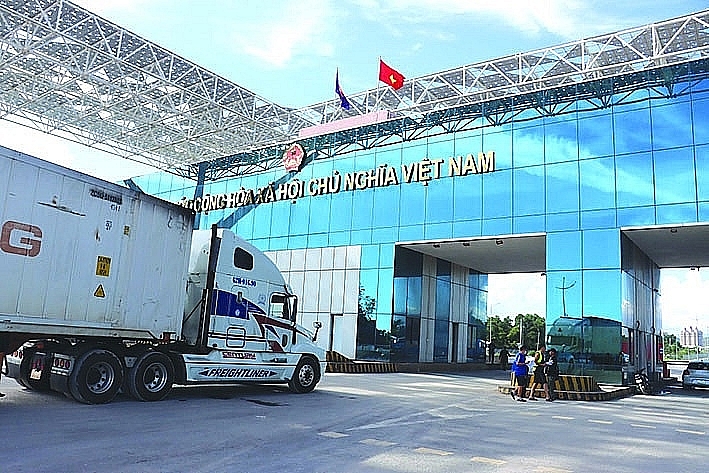China - Vietnam's top trading partner
As Vietnam's traditional partner, the trade relationship between Vietnam and China has continuously witnessed robust development, particularly since the two countries established a Comprehensive Strategic Cooperative Partnership in 2008.
 |
| Export-import activities with China through the Bac Luan II border gate (Mong Cai City, Quang Ninh). Photo: T. Binh |
Six consecutive years achieving a "hundred billion dollars" turnover
In more than 200 countries and territories with which Vietnam has trade relations, China is the largest partner.
Meanwhile, Vietnam is China's largest trading partner in the ASEAN bloc.
Since the two countries established a Comprehensive Strategic Cooperative Partnership in 2008, bilateral trade has continuously experienced strong growth.
In 2008, Vietnam-China bilateral trade reached only US$20 billion. By 2018, the trade volume with China surpassed US$100 billion for the first time (reaching around US$107 billion for the whole year), making China the first partner to achieve this scale.
According to the General Department of Customs, by the end of October, the import-export turnover between the two countries reached US$138.92 billion.
It is noteworthy that Vietnam's export activities have maintained positive growth, while import turnover has decreased.
Specifically, by the end of October, Vietnam's exports reached US$49.58 billion, an increase of 5.1% (equivalent to an increase of over US$2.4 billion) compared to the same period last year.
The most impressive growth in the export group was vegetables and fruits. Over the past ten months, vegetable and fruit exports to China reached US$3.18 billion, a 165% increase compared to the same period last year (equivalent to an additional US$1.8 billion in turnover).
Other key export groups with significant growth included computers, electronic products, and components, with a turnover of over US$11 billion, an increase of nearly 11.8% compared to the same period last year (equivalent to an additional US$1.16 billion in turnover).
Conversely, imports from China by the end of October reached US$89.34 billion, a decrease of over US$11 billion compared to the same period last year.
Since then, for six consecutive years (2018-2023), the scale of bilateral turnover has been continuously maintained at "hundred billion dollars," and although 2023 has not ended, the bilateral trade turnover has already exceeded US$100 billion.
In the history of trade relations between the two countries, a record turnover of over US$175 billion was recorded in 2022.
In 2022, 12 export groups of Vietnam achieved turnovers of US$1 billion or more, including two groups with turnovers exceeding US$10 billion: phones of all kinds and components with US$16.26 billion, and computers, electronic products, and components with US$11.88 billion. In general, Vietnam's exported goods to China are quite diverse, ranging from electronic products to agricultural products. Notably, there are three groups of agricultural products with a turnover in the billion-dollar range: wood and wood products, aquatic products, and vegetables and fruits.
On the flip side, imported goods from China are also very diverse. Remarkably, in 2022, there were 19 import groups from this market with turnovers of US$1 billion or more. Among them, there are also two groups in the "tens of billions" category: machinery, equipment, tools, and spare parts reaching US$24.29 billion, and computers, electronic products, and components reaching US$24 billion.
In a recent interview, Ambassador Pham Sao Mai of Vietnam to China stated that economic and trade cooperation continued to be a bright spot in the relationship between the two countries. In the context of reduced trade between China and most partners, Vietnam is one of the few partners maintaining stable trade with China
Prosperity in border regions
Economic and trade cooperation has played a significant role in improving the lives of people in both countries, especially in the northern border provinces of Vietnam.
Having visited several times to the border areas of China in provinces such as Quang Ninh, Lang Son, Cao Bang, Ha Giang, Lao Cai, Lai Chau, and Dien Bien, CustomsNews reporters have observed substantial changes in the socio-economic aspects of these border regions.
In particular, the road system and infrastructure in the border areas, and border gates such as Mong Cai, Hoanh Mo, Bac Phong Sinh (Quang Ninh); Huu Nghi, Tan Thanh, Chi Ma (Lang Son); Ta Lung, Tra Linh, Soc Giang (Cao Bang), or Thanh Thuy (Ha Giang), and Kim Thanh border gate (Lao Cai) have been fundamentally invested in to facilitate economic, cultural, and tourism exchanges between the people of the two countries.
Sharing with CustomsNews, many long-serving officials and public servants in the northern border customs units said that economic and trade development has been robust.
As the world's second-largest economy with a population scale of about 1.4 billion people, China is also a vital market for Vietnam's exports, especially agricultural products, thereby solving the crucial issue of outlets for the products of millions of farmers.
According to Dang Phuc Nguyen, General Secretary of the Vietnam Fruit and Vegetable Association (VINAFRUIT), the impressive development in the Chinese market has helped the Vietnamese fruit and vegetable industry achieve a record export turnover of over US$5 billion in 2023. The Chinese market alone accounts for over 60% of the country's fruit and vegetable export turnover and maintains a high three-digit growth rate in 2023.
The general secretary of VINAFRUIT shared that with the efforts of the relevant agencies of both countries, the business community, and the people, it was expected that fruit and vegetable exports to China in 2024 and the coming time would continue to yield positive results.
As observed by the CustomsNews reporter in the final days of 2023, thousands of trucks carrying import-export goods are undergoing customs clearance procedures daily on the northern border route. This doesn't include goods transported by sea, rail, and air, indicating the diversity and richness in the potential and advantages of economic and trade cooperation between Vietnam and China, providing the conditions for the import-export turnover between the two countries to set new records.










